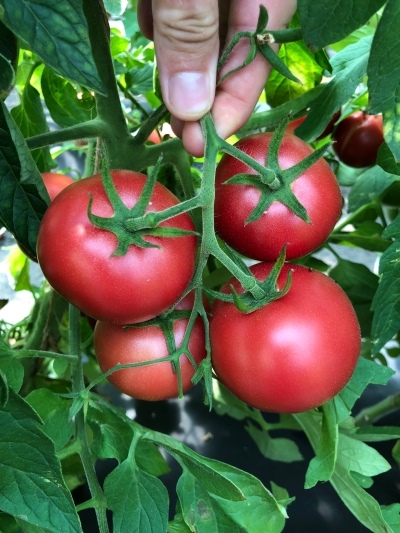
- Authors: Alekseev Yu.B.
- Year of approval: 2017
- Category: hybrid
- Growth type: determinant
- Appointment: fresh consumption
- Ripening period: ultra early
- Ripening time, days: 80-85
- Growing conditions: for open ground, for film greenhouses
- Transportability: Yes
- Bush height, cm: 60-70
In 2017, plant breeders had the opportunity to grow a pink Katya tomato on the site. This determinant variety is popular in many regions because it is not only tasty, but also does not need special care.
Description of the variety
Tomato is grown with equal success in greenhouses and open field. Bushes grow up to 70 cm high.
Fruits Pink Katya perfectly withstand transportation.
The main qualities of the fruit
Ripe tomatoes of the described variety are pink, hence the name. Medium in size, no more than 130 grams. Up to 6 ovaries are formed on the brush. The pulp is medium in density. They are well stored in a warehouse, under certain conditions.
Taste characteristics
Tomato Pink Katya tastes good. The fruits of the described hybrid are consumed fresh, for other purposes they are not suitable.
Ripening and fruiting
This variety belongs to the ultra-early, ripens in just 85 days.
Yield
Gives a yield at the level of 16.0-18.0 kg / sq. m.
The timing of planting seedlings and planting in the ground
Planting seeds for seedlings in early March, transfer to the ground - with the appearance of 5-6 main leaves.

Growing tomato seedlings is an extremely important process, because it largely depends on whether the gardener will be able to harvest at all. All aspects must be taken into account, from seedbed preparation to planting in the ground.
Landing scheme
The optimal planting pattern is 70 x 30 cm.

Growing and care
10 days before planting in open ground, the seedlings of Pink Katya begin to be prepared.
The temperature is lowered at night to 6-10 degrees and in the daytime to 12-15 degrees, the film is removed. When the temperature drops at night to –2 degrees, the greenhouse is covered again with foil. Before hardening, the seedlings of this variety are watered, bringing the soil moisture to 80%. During hardening, the seedlings are not watered. To improve the physiological and biochemical qualities and increase cold resistance, it is fed 1-2 days before planting with mineral fertilizers with an increased amount of potassium salts.
To do this, 10 g of ammonium nitrate, 40 g of superphosphate and 60-80 g of potassium sulfate are dissolved in 10 liters of water. This amount of solution is used to feed Pink Katya tomatoes on an area of 1.5 m2, followed by watering, bringing the soil moisture to 100%. 5-7 days before planting, in order to increase resistance against late blight, the seedlings are treated with 1% Bordeaux liquid or 0.1% copper sulfate solution at the rate of 1 liter per 1.5 m2.
Before planting, a standard 35-40-day seedling of the described variety should have a height (to the point of growth) 20-25 cm, 6-8 leaves, the weight of the aerial part is 13-16 g, the root weight is 0.6-1 g. The seedling yield is 200 -210 pcs. from 1 m2. Compliance with this technology contributes to obtaining hardened, harmoniously developed seedlings, suitable for planting.
The success of growing seedlings of Pink Katya in greenhouses depends on the timely implementation of preparatory work.For heating greenhouses, only fresh, not rotted manure is used.
For sowing, only conditioned seeds are taken, sorted in a 5% solution of sodium chloride and pickled in a 1% solution of potassium permanganate for 20 minutes, or in a 20% solution of hydrochloric acid. Immediately before sowing, the seeds are treated with TMTD (4 g per 1 kg of seeds).
They sow Pink Katya when the air temperature in greenhouses reaches 20-25 degrees. The sown seeds are sprinkled with a layer of soil mixture (0.5-1 cm) and watered.
After sowing, greenhouses are covered for 3-4 days. When germinating seeds of this variety, the temperature is maintained at 25-28 degrees, and with the emergence of seedlings for 5-7 days, it is reduced to 8-12 in the afternoon and 8-10 at night. Seedlings are watered with warm water (22-25 degrees) in the morning.
Tomato Pink Katya dives when two leaves appear in plants in pots or greenhouses that are moistened and warmed up to a temperature of 22-25 degrees. The planted plants are covered with earth up to the cotyledon leaves and lightly pressed with your fingers. Pots with dived seedlings are transferred to warm greenhouses. The gaps are filled with soil mixture. Pickled seedlings are well watered with warm water, covered and shaded for 2-3 days.




A plant needs different micronutrients at each stage of growth. All fertilizers can be divided into two groups: mineral and organic. Folk remedies are often used: iodine, yeast, bird droppings, eggshells.
It is important to observe the rate and period of feeding. This also applies to folk remedies and organic fertilizers.
Disease and pest resistance
What is remarkable about this variety is its high resistance to:
alternaria;
verticillosis;
tobacco mosaic virus;
fusarium wilting.
Moreover, the fruits of this variety are not prone to cracking.


Resistant to adverse weather conditions
Pink Katya is a heat-resistant variety.
Growing regions
A good harvest can be obtained in most regions of our country.

























































































